Australian School of Commerce: BSBWHS501 Safe Workplace Assignment
VerifiedAdded on 2022/10/01
|10
|1779
|66
Homework Assignment
AI Summary
This assignment addresses the core principles of workplace health and safety, focusing on the application of the Work Health and Safety Act 2011. It covers essential aspects such as the hierarchy of control, employer and worker obligations, consultation requirements, and the role of health and safety representatives. The document outlines hazard identification processes, risk assessment methodologies, and risk control strategies, including administrative controls and personal protective equipment (PPE). It also highlights the importance of record-keeping, due diligence, and the consequences of non-compliance with OHS/WHS laws, including common failures and the importance of regular monitoring and information management. The assignment concludes by listing various types of workplace hazards.
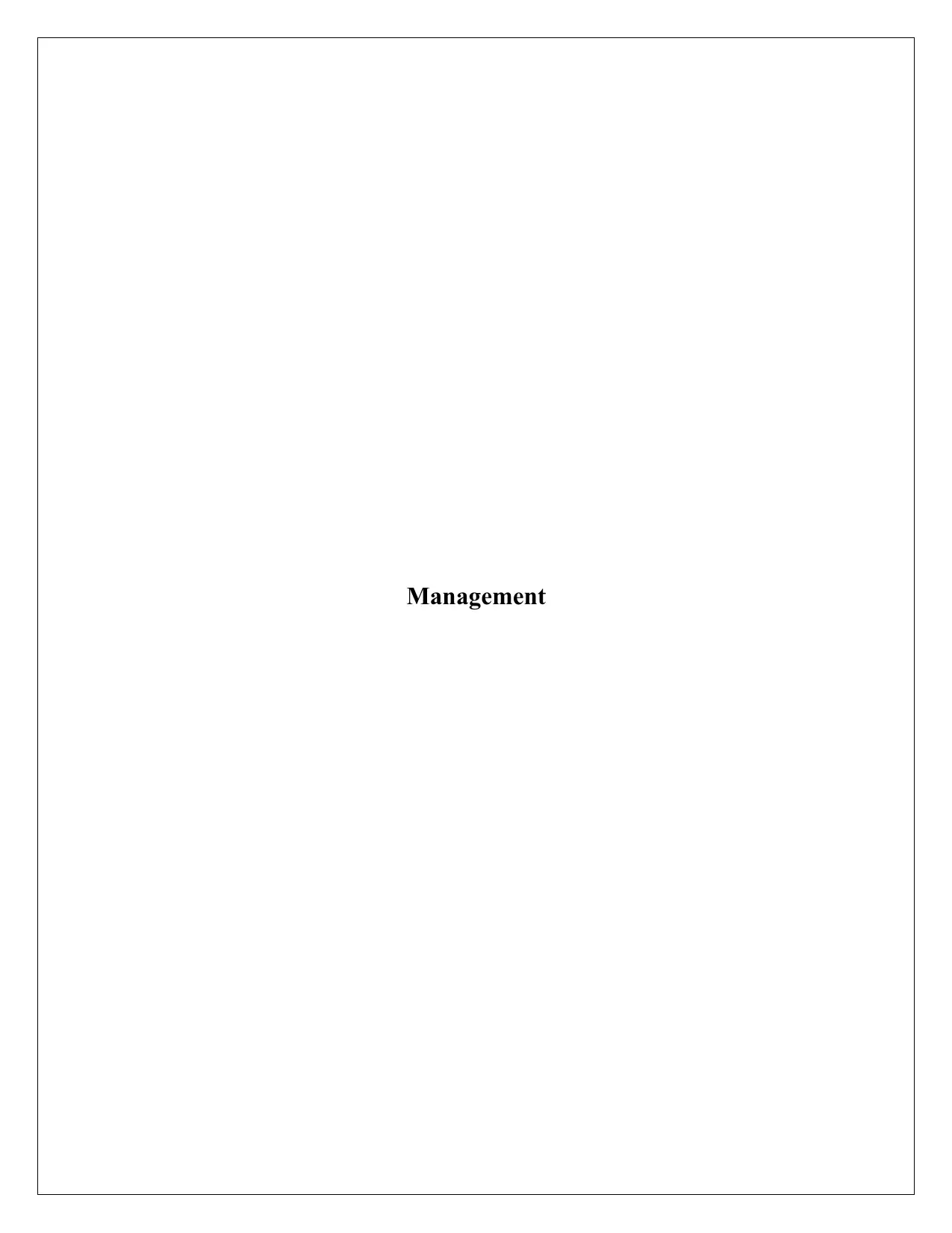
Management
Paraphrase This Document
Need a fresh take? Get an instant paraphrase of this document with our AI Paraphraser
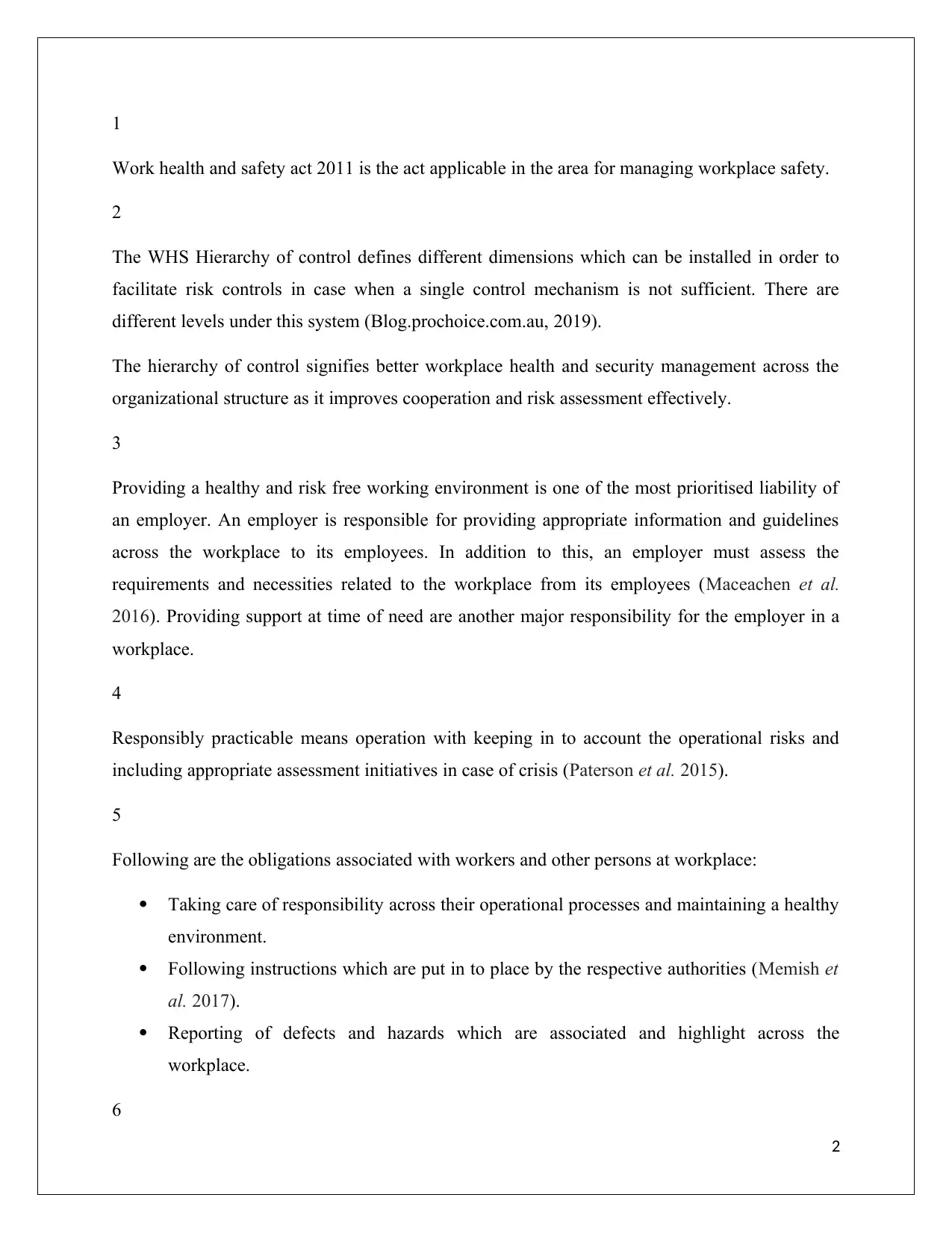
1
Work health and safety act 2011 is the act applicable in the area for managing workplace safety.
2
The WHS Hierarchy of control defines different dimensions which can be installed in order to
facilitate risk controls in case when a single control mechanism is not sufficient. There are
different levels under this system (Blog.prochoice.com.au, 2019).
The hierarchy of control signifies better workplace health and security management across the
organizational structure as it improves cooperation and risk assessment effectively.
3
Providing a healthy and risk free working environment is one of the most prioritised liability of
an employer. An employer is responsible for providing appropriate information and guidelines
across the workplace to its employees. In addition to this, an employer must assess the
requirements and necessities related to the workplace from its employees (Maceachen et al.
2016). Providing support at time of need are another major responsibility for the employer in a
workplace.
4
Responsibly practicable means operation with keeping in to account the operational risks and
including appropriate assessment initiatives in case of crisis (Paterson et al. 2015).
5
Following are the obligations associated with workers and other persons at workplace:
Taking care of responsibility across their operational processes and maintaining a healthy
environment.
Following instructions which are put in to place by the respective authorities (Memish et
al. 2017).
Reporting of defects and hazards which are associated and highlight across the
workplace.
6
2
Work health and safety act 2011 is the act applicable in the area for managing workplace safety.
2
The WHS Hierarchy of control defines different dimensions which can be installed in order to
facilitate risk controls in case when a single control mechanism is not sufficient. There are
different levels under this system (Blog.prochoice.com.au, 2019).
The hierarchy of control signifies better workplace health and security management across the
organizational structure as it improves cooperation and risk assessment effectively.
3
Providing a healthy and risk free working environment is one of the most prioritised liability of
an employer. An employer is responsible for providing appropriate information and guidelines
across the workplace to its employees. In addition to this, an employer must assess the
requirements and necessities related to the workplace from its employees (Maceachen et al.
2016). Providing support at time of need are another major responsibility for the employer in a
workplace.
4
Responsibly practicable means operation with keeping in to account the operational risks and
including appropriate assessment initiatives in case of crisis (Paterson et al. 2015).
5
Following are the obligations associated with workers and other persons at workplace:
Taking care of responsibility across their operational processes and maintaining a healthy
environment.
Following instructions which are put in to place by the respective authorities (Memish et
al. 2017).
Reporting of defects and hazards which are associated and highlight across the
workplace.
6
2
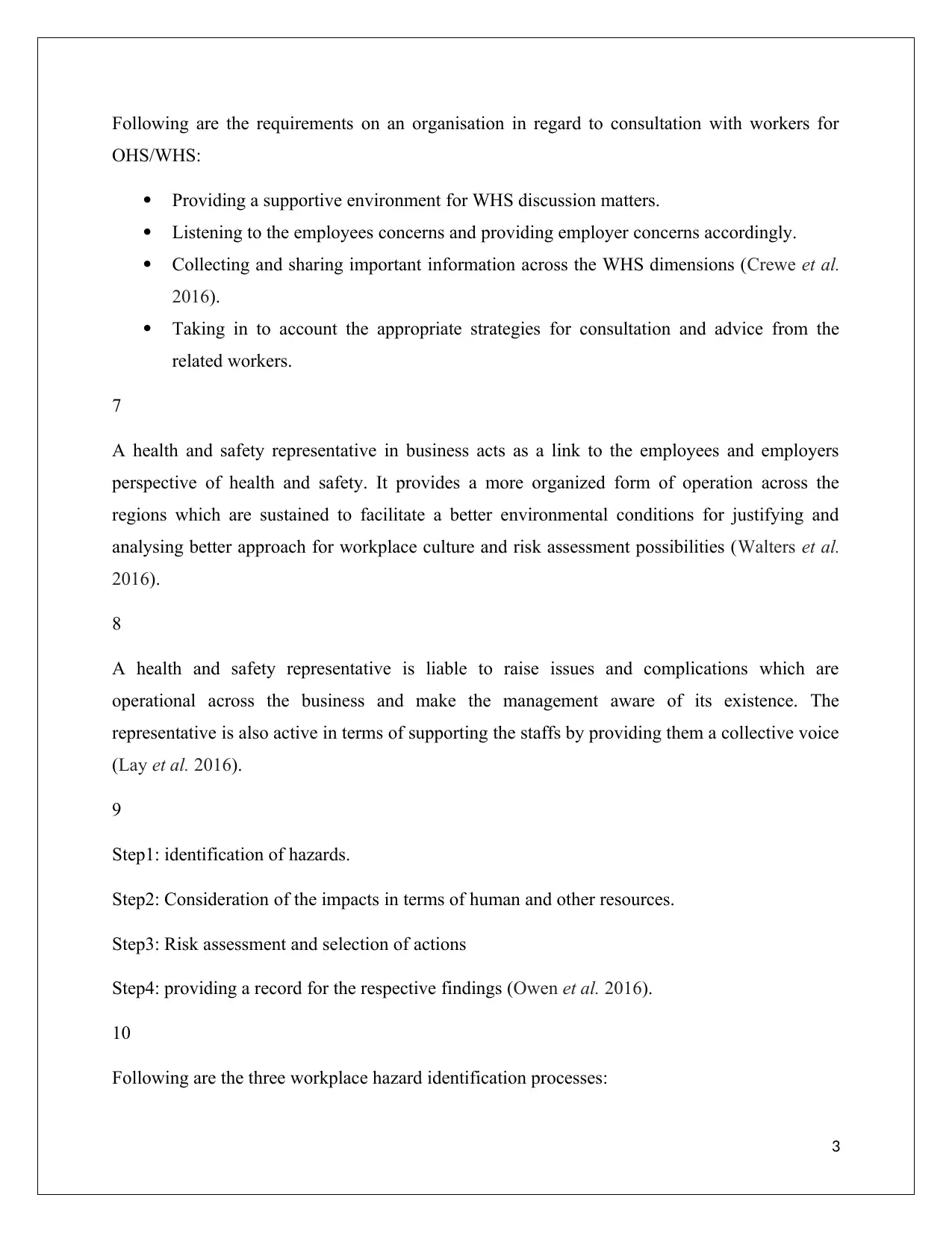
Following are the requirements on an organisation in regard to consultation with workers for
OHS/WHS:
Providing a supportive environment for WHS discussion matters.
Listening to the employees concerns and providing employer concerns accordingly.
Collecting and sharing important information across the WHS dimensions (Crewe et al.
2016).
Taking in to account the appropriate strategies for consultation and advice from the
related workers.
7
A health and safety representative in business acts as a link to the employees and employers
perspective of health and safety. It provides a more organized form of operation across the
regions which are sustained to facilitate a better environmental conditions for justifying and
analysing better approach for workplace culture and risk assessment possibilities (Walters et al.
2016).
8
A health and safety representative is liable to raise issues and complications which are
operational across the business and make the management aware of its existence. The
representative is also active in terms of supporting the staffs by providing them a collective voice
(Lay et al. 2016).
9
Step1: identification of hazards.
Step2: Consideration of the impacts in terms of human and other resources.
Step3: Risk assessment and selection of actions
Step4: providing a record for the respective findings (Owen et al. 2016).
10
Following are the three workplace hazard identification processes:
3
OHS/WHS:
Providing a supportive environment for WHS discussion matters.
Listening to the employees concerns and providing employer concerns accordingly.
Collecting and sharing important information across the WHS dimensions (Crewe et al.
2016).
Taking in to account the appropriate strategies for consultation and advice from the
related workers.
7
A health and safety representative in business acts as a link to the employees and employers
perspective of health and safety. It provides a more organized form of operation across the
regions which are sustained to facilitate a better environmental conditions for justifying and
analysing better approach for workplace culture and risk assessment possibilities (Walters et al.
2016).
8
A health and safety representative is liable to raise issues and complications which are
operational across the business and make the management aware of its existence. The
representative is also active in terms of supporting the staffs by providing them a collective voice
(Lay et al. 2016).
9
Step1: identification of hazards.
Step2: Consideration of the impacts in terms of human and other resources.
Step3: Risk assessment and selection of actions
Step4: providing a record for the respective findings (Owen et al. 2016).
10
Following are the three workplace hazard identification processes:
3
⊘ This is a preview!⊘
Do you want full access?
Subscribe today to unlock all pages.

Trusted by 1+ million students worldwide
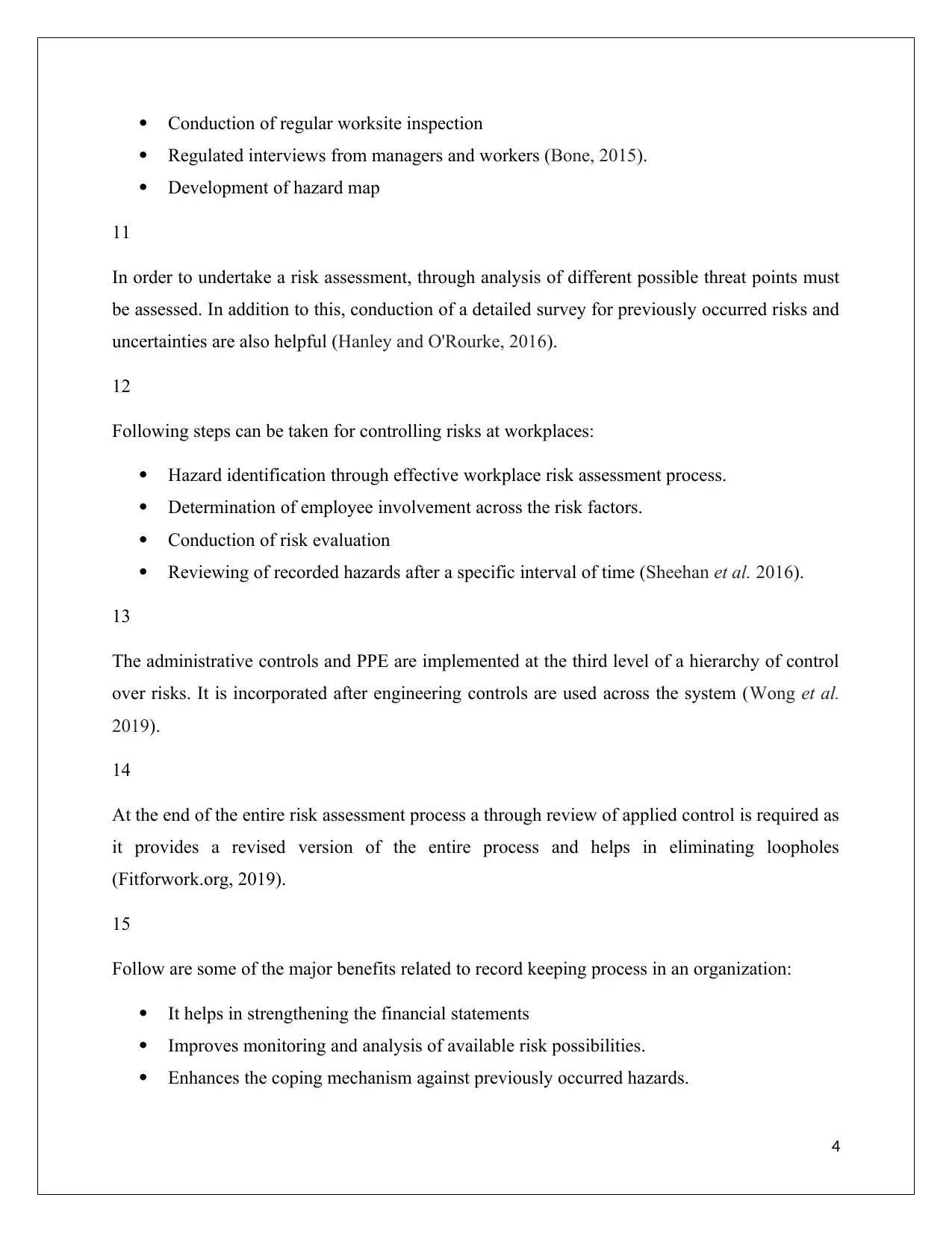
Conduction of regular worksite inspection
Regulated interviews from managers and workers (Bone, 2015).
Development of hazard map
11
In order to undertake a risk assessment, through analysis of different possible threat points must
be assessed. In addition to this, conduction of a detailed survey for previously occurred risks and
uncertainties are also helpful (Hanley and O'Rourke, 2016).
12
Following steps can be taken for controlling risks at workplaces:
Hazard identification through effective workplace risk assessment process.
Determination of employee involvement across the risk factors.
Conduction of risk evaluation
Reviewing of recorded hazards after a specific interval of time (Sheehan et al. 2016).
13
The administrative controls and PPE are implemented at the third level of a hierarchy of control
over risks. It is incorporated after engineering controls are used across the system (Wong et al.
2019).
14
At the end of the entire risk assessment process a through review of applied control is required as
it provides a revised version of the entire process and helps in eliminating loopholes
(Fitforwork.org, 2019).
15
Follow are some of the major benefits related to record keeping process in an organization:
It helps in strengthening the financial statements
Improves monitoring and analysis of available risk possibilities.
Enhances the coping mechanism against previously occurred hazards.
4
Regulated interviews from managers and workers (Bone, 2015).
Development of hazard map
11
In order to undertake a risk assessment, through analysis of different possible threat points must
be assessed. In addition to this, conduction of a detailed survey for previously occurred risks and
uncertainties are also helpful (Hanley and O'Rourke, 2016).
12
Following steps can be taken for controlling risks at workplaces:
Hazard identification through effective workplace risk assessment process.
Determination of employee involvement across the risk factors.
Conduction of risk evaluation
Reviewing of recorded hazards after a specific interval of time (Sheehan et al. 2016).
13
The administrative controls and PPE are implemented at the third level of a hierarchy of control
over risks. It is incorporated after engineering controls are used across the system (Wong et al.
2019).
14
At the end of the entire risk assessment process a through review of applied control is required as
it provides a revised version of the entire process and helps in eliminating loopholes
(Fitforwork.org, 2019).
15
Follow are some of the major benefits related to record keeping process in an organization:
It helps in strengthening the financial statements
Improves monitoring and analysis of available risk possibilities.
Enhances the coping mechanism against previously occurred hazards.
4
Paraphrase This Document
Need a fresh take? Get an instant paraphrase of this document with our AI Paraphraser
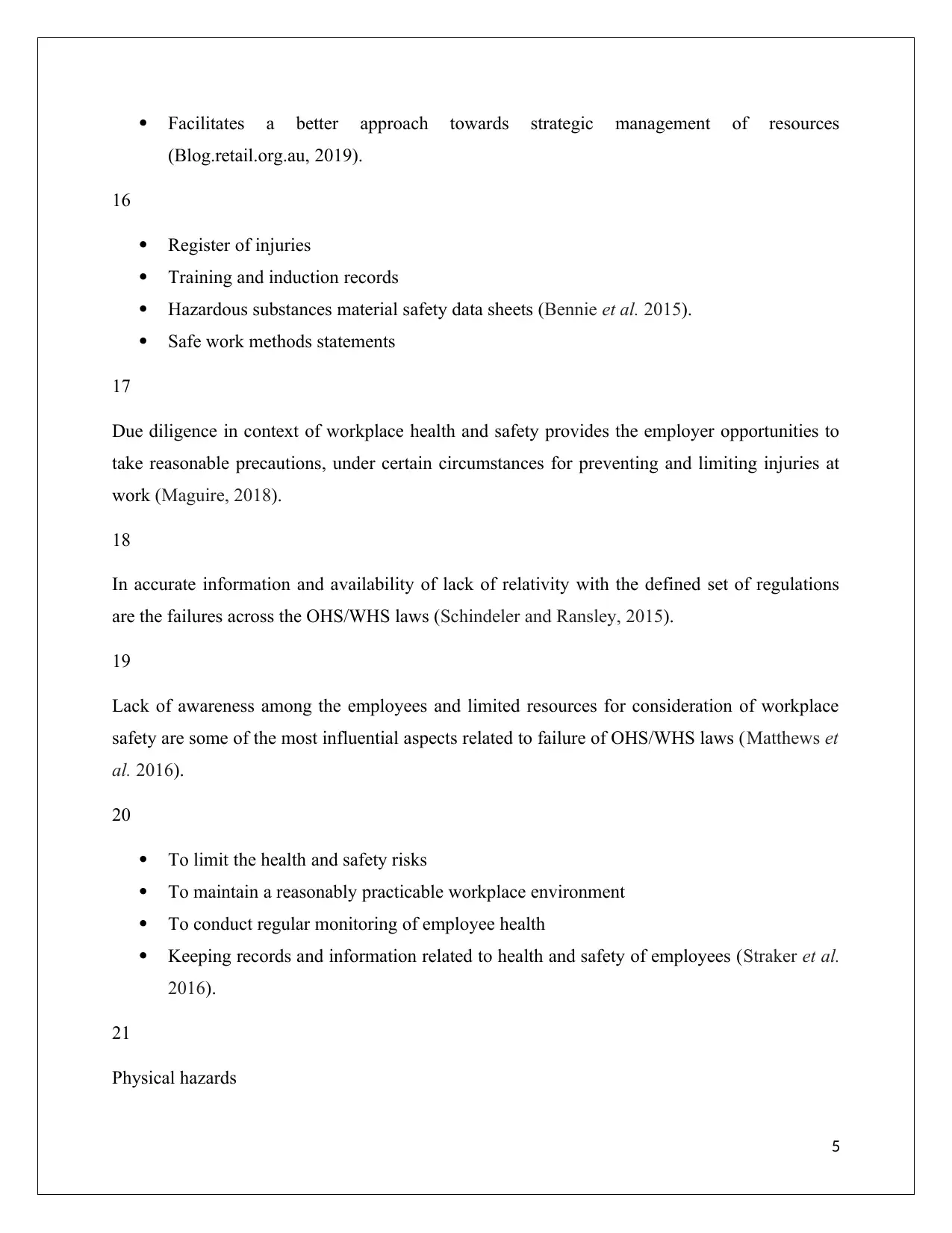
Facilitates a better approach towards strategic management of resources
(Blog.retail.org.au, 2019).
16
Register of injuries
Training and induction records
Hazardous substances material safety data sheets (Bennie et al. 2015).
Safe work methods statements
17
Due diligence in context of workplace health and safety provides the employer opportunities to
take reasonable precautions, under certain circumstances for preventing and limiting injuries at
work (Maguire, 2018).
18
In accurate information and availability of lack of relativity with the defined set of regulations
are the failures across the OHS/WHS laws (Schindeler and Ransley, 2015).
19
Lack of awareness among the employees and limited resources for consideration of workplace
safety are some of the most influential aspects related to failure of OHS/WHS laws (Matthews et
al. 2016).
20
To limit the health and safety risks
To maintain a reasonably practicable workplace environment
To conduct regular monitoring of employee health
Keeping records and information related to health and safety of employees (Straker et al.
2016).
21
Physical hazards
5
(Blog.retail.org.au, 2019).
16
Register of injuries
Training and induction records
Hazardous substances material safety data sheets (Bennie et al. 2015).
Safe work methods statements
17
Due diligence in context of workplace health and safety provides the employer opportunities to
take reasonable precautions, under certain circumstances for preventing and limiting injuries at
work (Maguire, 2018).
18
In accurate information and availability of lack of relativity with the defined set of regulations
are the failures across the OHS/WHS laws (Schindeler and Ransley, 2015).
19
Lack of awareness among the employees and limited resources for consideration of workplace
safety are some of the most influential aspects related to failure of OHS/WHS laws (Matthews et
al. 2016).
20
To limit the health and safety risks
To maintain a reasonably practicable workplace environment
To conduct regular monitoring of employee health
Keeping records and information related to health and safety of employees (Straker et al.
2016).
21
Physical hazards
5
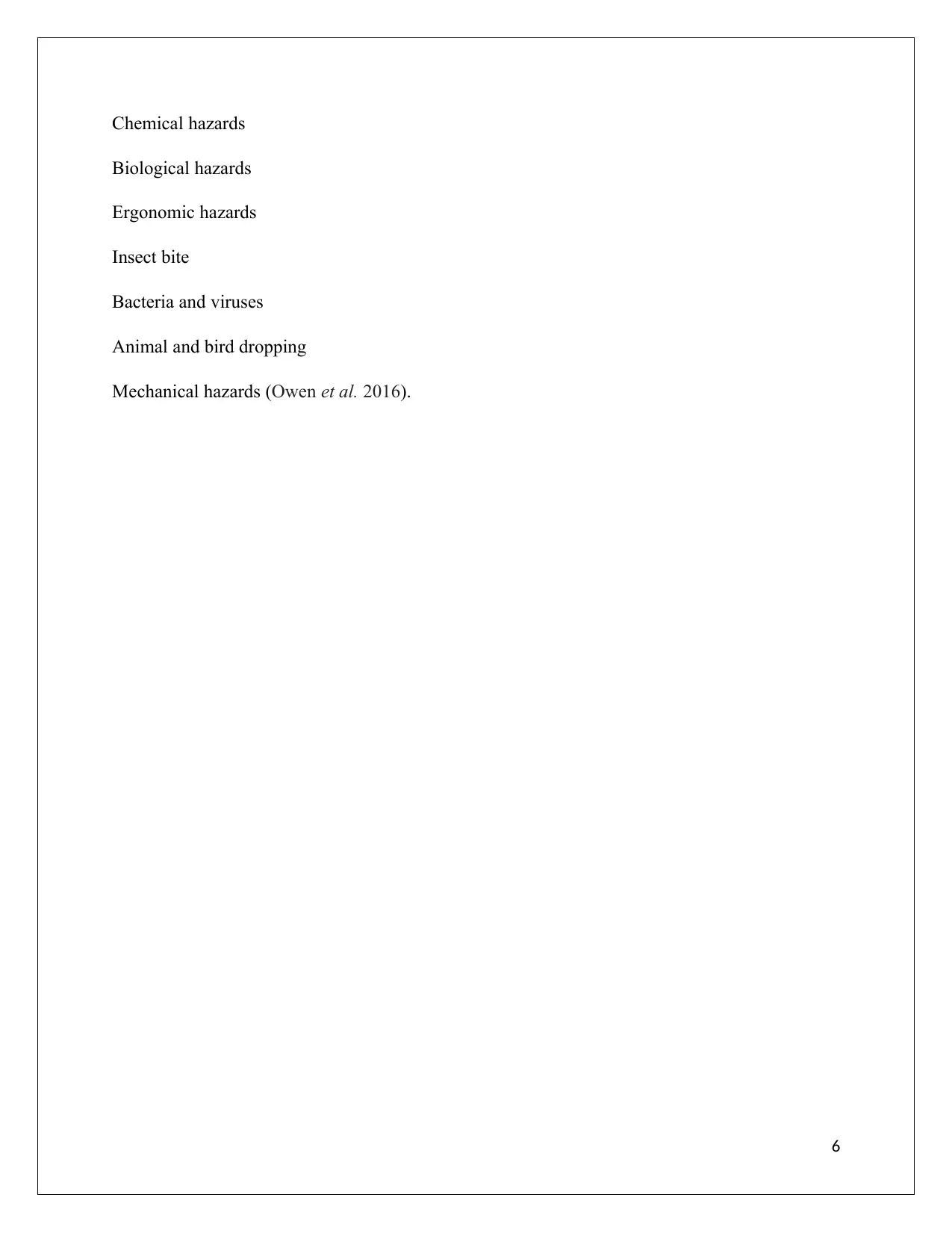
Chemical hazards
Biological hazards
Ergonomic hazards
Insect bite
Bacteria and viruses
Animal and bird dropping
Mechanical hazards (Owen et al. 2016).
6
Biological hazards
Ergonomic hazards
Insect bite
Bacteria and viruses
Animal and bird dropping
Mechanical hazards (Owen et al. 2016).
6
⊘ This is a preview!⊘
Do you want full access?
Subscribe today to unlock all pages.

Trusted by 1+ million students worldwide
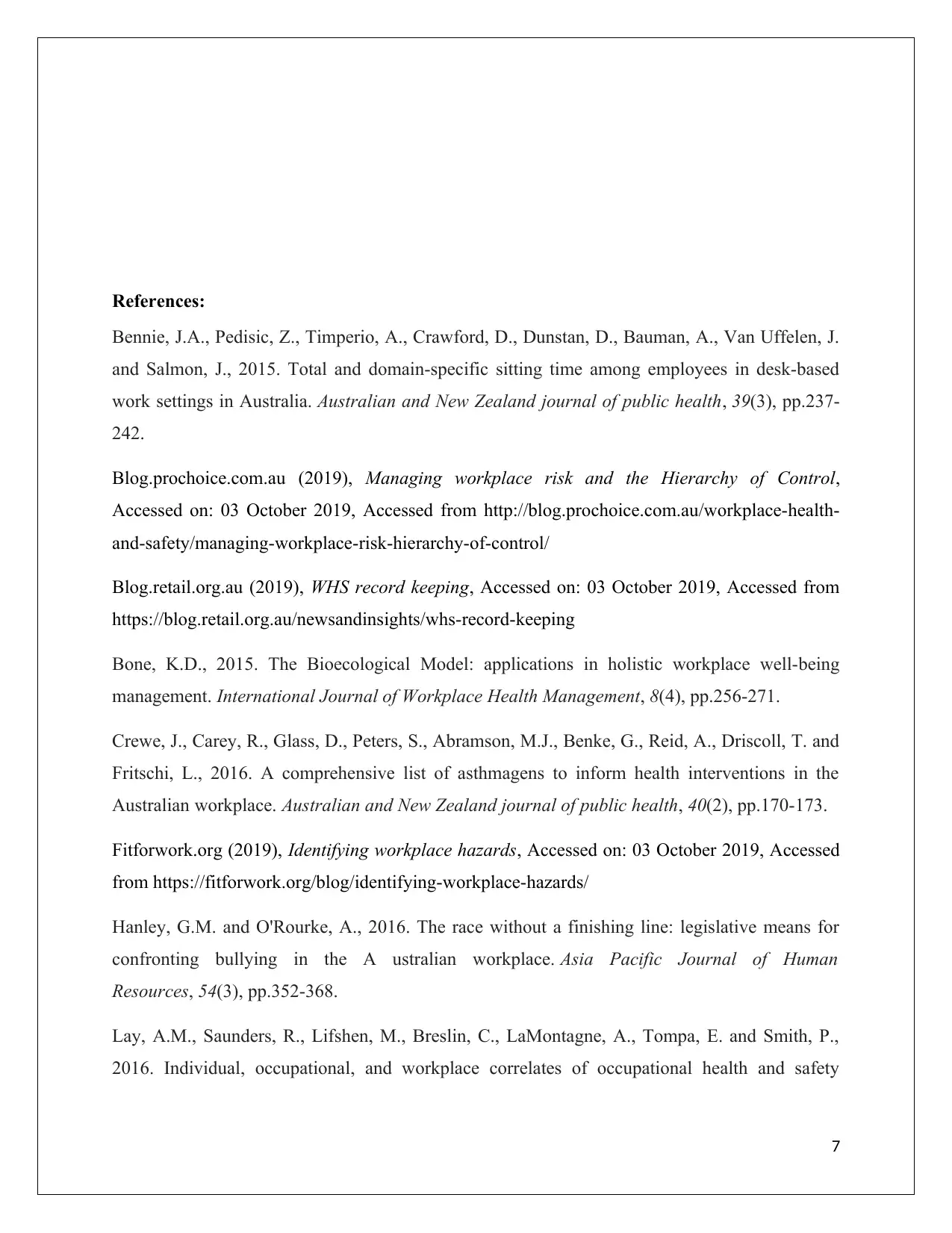
References:
Bennie, J.A., Pedisic, Z., Timperio, A., Crawford, D., Dunstan, D., Bauman, A., Van Uffelen, J.
and Salmon, J., 2015. Total and domain‐specific sitting time among employees in desk‐based
work settings in Australia. Australian and New Zealand journal of public health, 39(3), pp.237-
242.
Blog.prochoice.com.au (2019), Managing workplace risk and the Hierarchy of Control,
Accessed on: 03 October 2019, Accessed from http://blog.prochoice.com.au/workplace-health-
and-safety/managing-workplace-risk-hierarchy-of-control/
Blog.retail.org.au (2019), WHS record keeping, Accessed on: 03 October 2019, Accessed from
https://blog.retail.org.au/newsandinsights/whs-record-keeping
Bone, K.D., 2015. The Bioecological Model: applications in holistic workplace well-being
management. International Journal of Workplace Health Management, 8(4), pp.256-271.
Crewe, J., Carey, R., Glass, D., Peters, S., Abramson, M.J., Benke, G., Reid, A., Driscoll, T. and
Fritschi, L., 2016. A comprehensive list of asthmagens to inform health interventions in the
Australian workplace. Australian and New Zealand journal of public health, 40(2), pp.170-173.
Fitforwork.org (2019), Identifying workplace hazards, Accessed on: 03 October 2019, Accessed
from https://fitforwork.org/blog/identifying-workplace-hazards/
Hanley, G.M. and O'Rourke, A., 2016. The race without a finishing line: legislative means for
confronting bullying in the A ustralian workplace. Asia Pacific Journal of Human
Resources, 54(3), pp.352-368.
Lay, A.M., Saunders, R., Lifshen, M., Breslin, C., LaMontagne, A., Tompa, E. and Smith, P.,
2016. Individual, occupational, and workplace correlates of occupational health and safety
7
Bennie, J.A., Pedisic, Z., Timperio, A., Crawford, D., Dunstan, D., Bauman, A., Van Uffelen, J.
and Salmon, J., 2015. Total and domain‐specific sitting time among employees in desk‐based
work settings in Australia. Australian and New Zealand journal of public health, 39(3), pp.237-
242.
Blog.prochoice.com.au (2019), Managing workplace risk and the Hierarchy of Control,
Accessed on: 03 October 2019, Accessed from http://blog.prochoice.com.au/workplace-health-
and-safety/managing-workplace-risk-hierarchy-of-control/
Blog.retail.org.au (2019), WHS record keeping, Accessed on: 03 October 2019, Accessed from
https://blog.retail.org.au/newsandinsights/whs-record-keeping
Bone, K.D., 2015. The Bioecological Model: applications in holistic workplace well-being
management. International Journal of Workplace Health Management, 8(4), pp.256-271.
Crewe, J., Carey, R., Glass, D., Peters, S., Abramson, M.J., Benke, G., Reid, A., Driscoll, T. and
Fritschi, L., 2016. A comprehensive list of asthmagens to inform health interventions in the
Australian workplace. Australian and New Zealand journal of public health, 40(2), pp.170-173.
Fitforwork.org (2019), Identifying workplace hazards, Accessed on: 03 October 2019, Accessed
from https://fitforwork.org/blog/identifying-workplace-hazards/
Hanley, G.M. and O'Rourke, A., 2016. The race without a finishing line: legislative means for
confronting bullying in the A ustralian workplace. Asia Pacific Journal of Human
Resources, 54(3), pp.352-368.
Lay, A.M., Saunders, R., Lifshen, M., Breslin, C., LaMontagne, A., Tompa, E. and Smith, P.,
2016. Individual, occupational, and workplace correlates of occupational health and safety
7
Paraphrase This Document
Need a fresh take? Get an instant paraphrase of this document with our AI Paraphraser
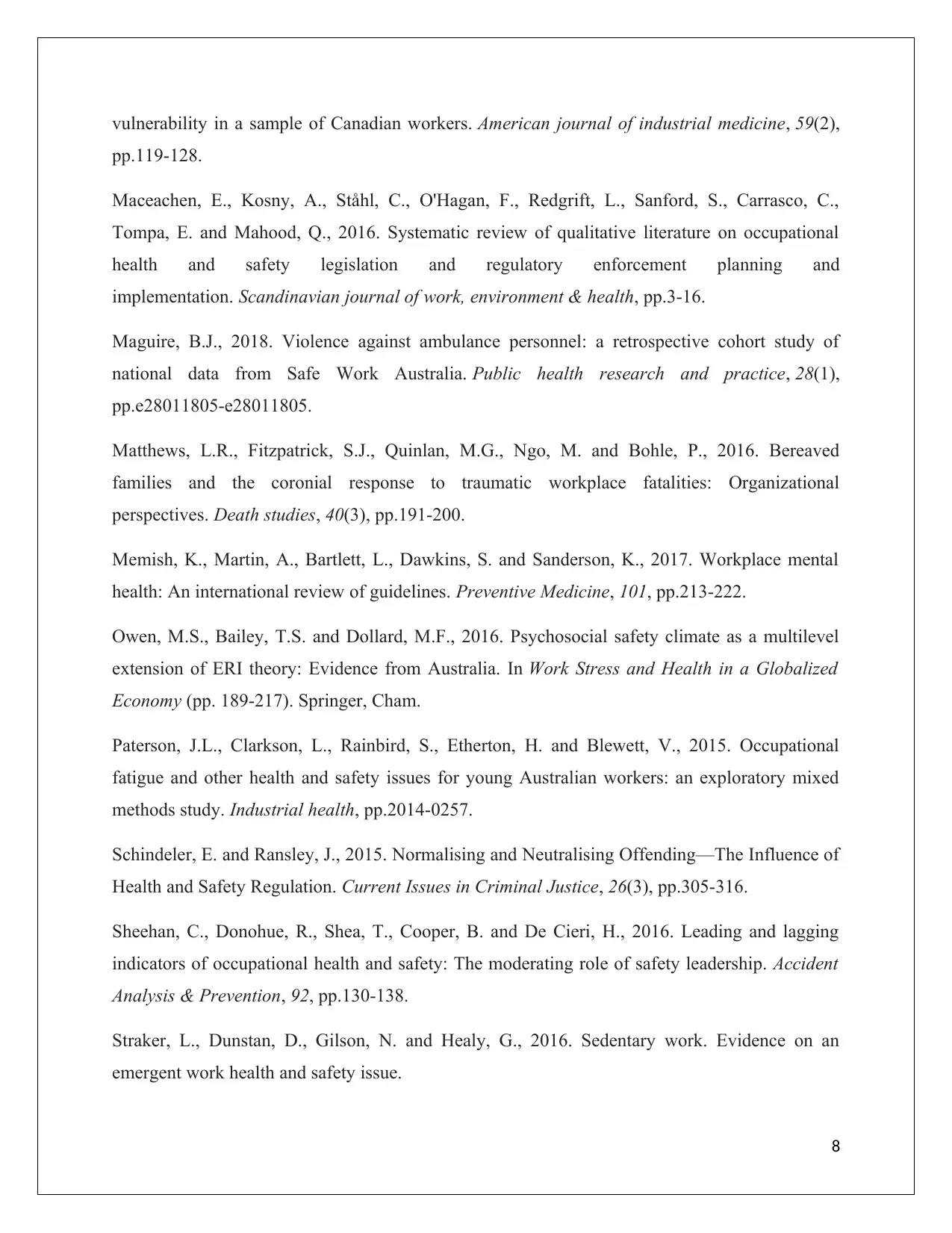
vulnerability in a sample of Canadian workers. American journal of industrial medicine, 59(2),
pp.119-128.
Maceachen, E., Kosny, A., Ståhl, C., O'Hagan, F., Redgrift, L., Sanford, S., Carrasco, C.,
Tompa, E. and Mahood, Q., 2016. Systematic review of qualitative literature on occupational
health and safety legislation and regulatory enforcement planning and
implementation. Scandinavian journal of work, environment & health, pp.3-16.
Maguire, B.J., 2018. Violence against ambulance personnel: a retrospective cohort study of
national data from Safe Work Australia. Public health research and practice, 28(1),
pp.e28011805-e28011805.
Matthews, L.R., Fitzpatrick, S.J., Quinlan, M.G., Ngo, M. and Bohle, P., 2016. Bereaved
families and the coronial response to traumatic workplace fatalities: Organizational
perspectives. Death studies, 40(3), pp.191-200.
Memish, K., Martin, A., Bartlett, L., Dawkins, S. and Sanderson, K., 2017. Workplace mental
health: An international review of guidelines. Preventive Medicine, 101, pp.213-222.
Owen, M.S., Bailey, T.S. and Dollard, M.F., 2016. Psychosocial safety climate as a multilevel
extension of ERI theory: Evidence from Australia. In Work Stress and Health in a Globalized
Economy (pp. 189-217). Springer, Cham.
Paterson, J.L., Clarkson, L., Rainbird, S., Etherton, H. and Blewett, V., 2015. Occupational
fatigue and other health and safety issues for young Australian workers: an exploratory mixed
methods study. Industrial health, pp.2014-0257.
Schindeler, E. and Ransley, J., 2015. Normalising and Neutralising Offending—The Influence of
Health and Safety Regulation. Current Issues in Criminal Justice, 26(3), pp.305-316.
Sheehan, C., Donohue, R., Shea, T., Cooper, B. and De Cieri, H., 2016. Leading and lagging
indicators of occupational health and safety: The moderating role of safety leadership. Accident
Analysis & Prevention, 92, pp.130-138.
Straker, L., Dunstan, D., Gilson, N. and Healy, G., 2016. Sedentary work. Evidence on an
emergent work health and safety issue.
8
pp.119-128.
Maceachen, E., Kosny, A., Ståhl, C., O'Hagan, F., Redgrift, L., Sanford, S., Carrasco, C.,
Tompa, E. and Mahood, Q., 2016. Systematic review of qualitative literature on occupational
health and safety legislation and regulatory enforcement planning and
implementation. Scandinavian journal of work, environment & health, pp.3-16.
Maguire, B.J., 2018. Violence against ambulance personnel: a retrospective cohort study of
national data from Safe Work Australia. Public health research and practice, 28(1),
pp.e28011805-e28011805.
Matthews, L.R., Fitzpatrick, S.J., Quinlan, M.G., Ngo, M. and Bohle, P., 2016. Bereaved
families and the coronial response to traumatic workplace fatalities: Organizational
perspectives. Death studies, 40(3), pp.191-200.
Memish, K., Martin, A., Bartlett, L., Dawkins, S. and Sanderson, K., 2017. Workplace mental
health: An international review of guidelines. Preventive Medicine, 101, pp.213-222.
Owen, M.S., Bailey, T.S. and Dollard, M.F., 2016. Psychosocial safety climate as a multilevel
extension of ERI theory: Evidence from Australia. In Work Stress and Health in a Globalized
Economy (pp. 189-217). Springer, Cham.
Paterson, J.L., Clarkson, L., Rainbird, S., Etherton, H. and Blewett, V., 2015. Occupational
fatigue and other health and safety issues for young Australian workers: an exploratory mixed
methods study. Industrial health, pp.2014-0257.
Schindeler, E. and Ransley, J., 2015. Normalising and Neutralising Offending—The Influence of
Health and Safety Regulation. Current Issues in Criminal Justice, 26(3), pp.305-316.
Sheehan, C., Donohue, R., Shea, T., Cooper, B. and De Cieri, H., 2016. Leading and lagging
indicators of occupational health and safety: The moderating role of safety leadership. Accident
Analysis & Prevention, 92, pp.130-138.
Straker, L., Dunstan, D., Gilson, N. and Healy, G., 2016. Sedentary work. Evidence on an
emergent work health and safety issue.
8
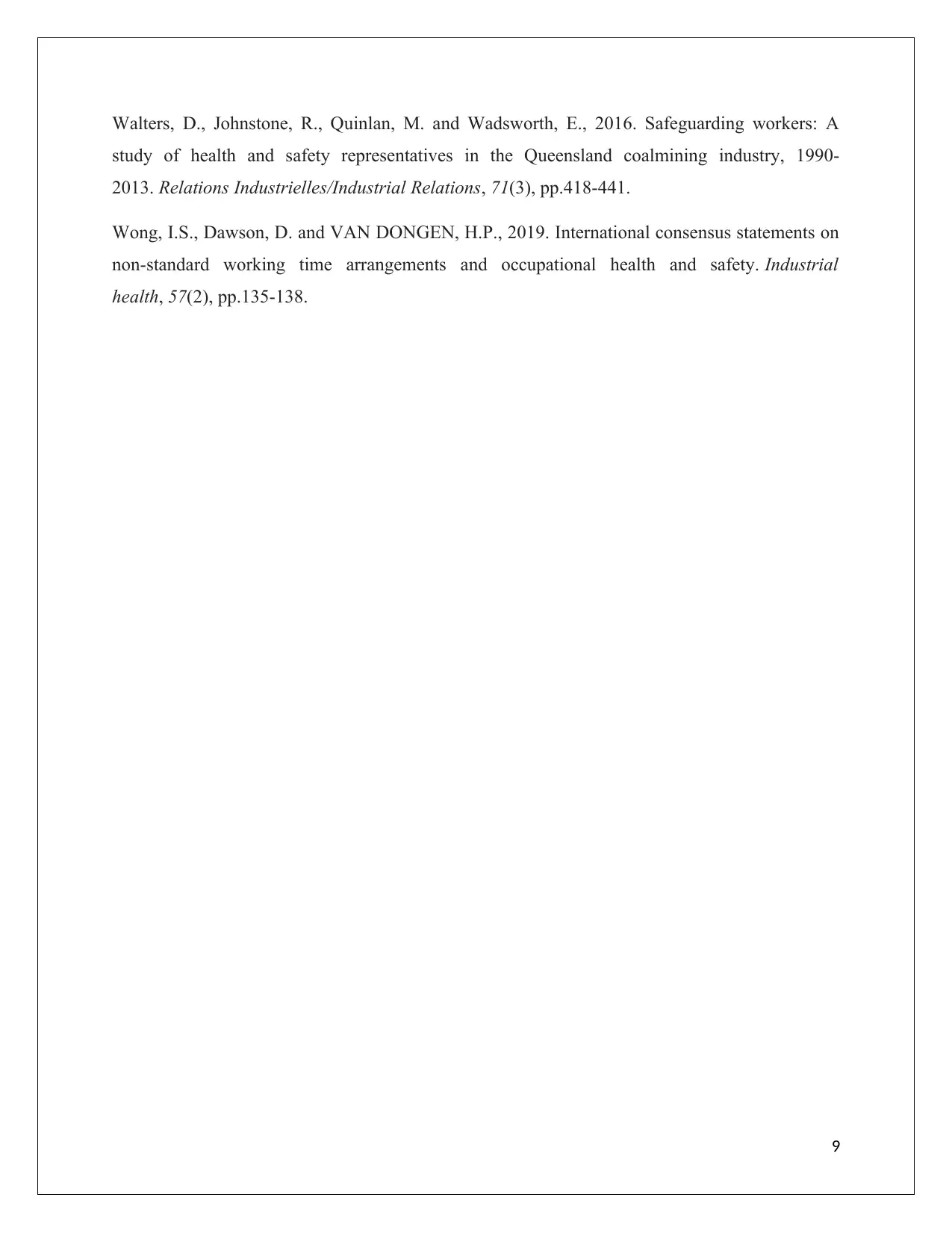
Walters, D., Johnstone, R., Quinlan, M. and Wadsworth, E., 2016. Safeguarding workers: A
study of health and safety representatives in the Queensland coalmining industry, 1990-
2013. Relations Industrielles/Industrial Relations, 71(3), pp.418-441.
Wong, I.S., Dawson, D. and VAN DONGEN, H.P., 2019. International consensus statements on
non-standard working time arrangements and occupational health and safety. Industrial
health, 57(2), pp.135-138.
9
study of health and safety representatives in the Queensland coalmining industry, 1990-
2013. Relations Industrielles/Industrial Relations, 71(3), pp.418-441.
Wong, I.S., Dawson, D. and VAN DONGEN, H.P., 2019. International consensus statements on
non-standard working time arrangements and occupational health and safety. Industrial
health, 57(2), pp.135-138.
9
⊘ This is a preview!⊘
Do you want full access?
Subscribe today to unlock all pages.

Trusted by 1+ million students worldwide
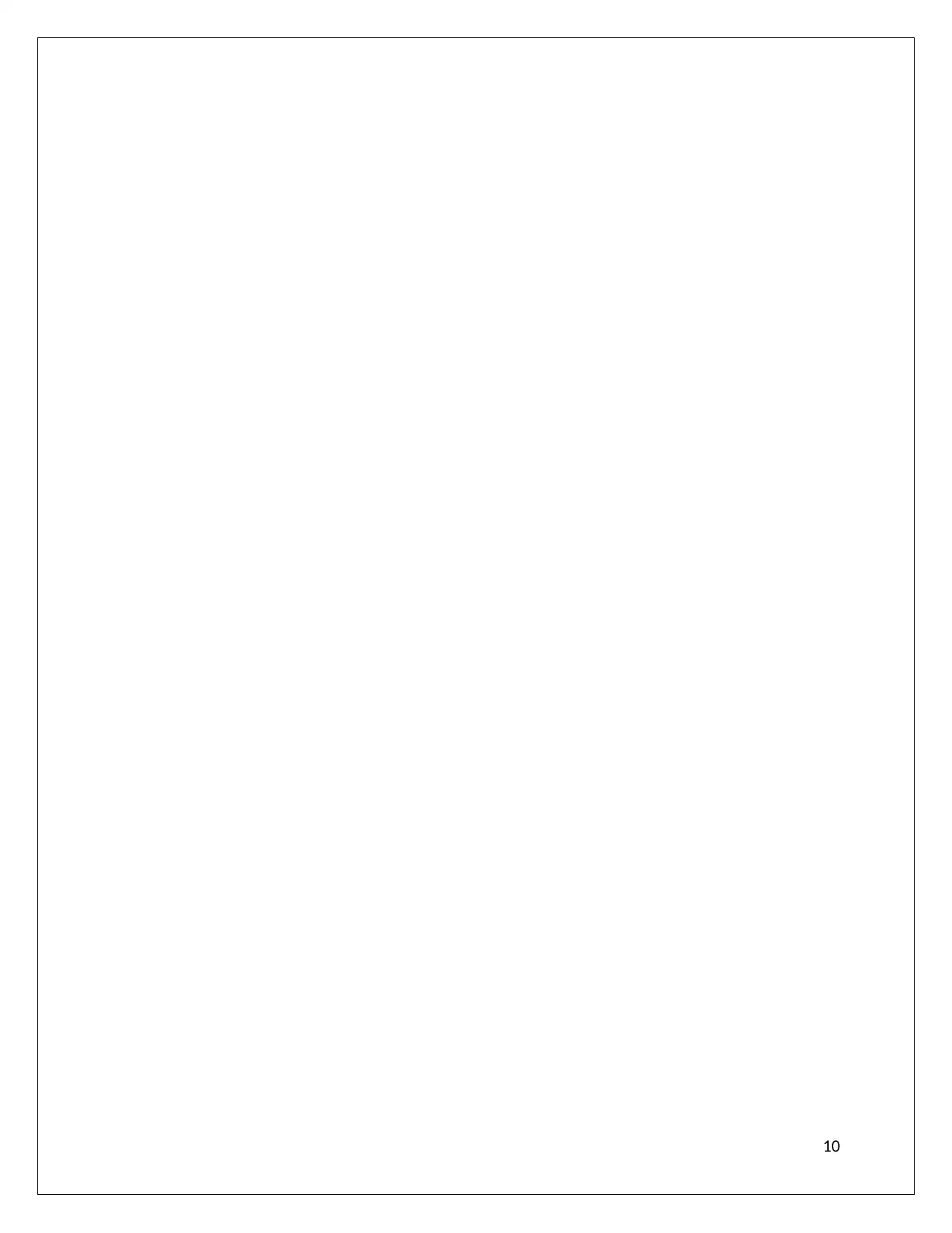
10
1 out of 10
Related Documents
Your All-in-One AI-Powered Toolkit for Academic Success.
+13062052269
info@desklib.com
Available 24*7 on WhatsApp / Email
![[object Object]](/_next/static/media/star-bottom.7253800d.svg)
Unlock your academic potential
Copyright © 2020–2025 A2Z Services. All Rights Reserved. Developed and managed by ZUCOL.





